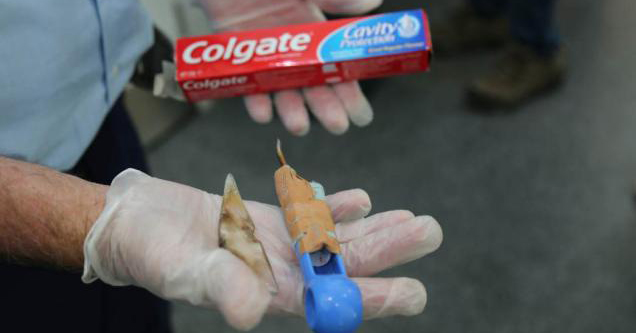
For example, while most prisoners wouldn’t be concerned about possession of stolen packs of peanut butter, they wouldn’t want to be caught with an intoxicant or drugs. In all honesty, most prisoners do have contraband items, but to differing degrees. If found guilty, this can result in a disciplinary transfer to a higher security prison, solitary confinement, loss of good conduct time, and many months loss of various privileges.
Prison contraband series#
Possession of a weapon, alcohol, and other such items (e.g., escape tools) can result in a 100 series incident report. An incident report for hard contraband is a different story due to it being a much more serious infraction.
Prison contraband code#
When actually written up for it, soft contraband usually results in a Code 305, Possession of Anything Not Authorized, incident report, which is usually good for 30 to 90 days loss of a privilege (e.g., email, commissary, telephone, etc.). Depending on the person conducting the search, if soft contraband is found, they will either allow you to keep it, simply throw it away, or tell you to get rid of it. If hard contraband is found, you can count on it being confiscated and receiving an incident report. Pornography falls somewhere between the two categories. Soft contraband can consist of food stolen from Food Service, excess property, and other less serious items. Hard contraband consists of weapons, drugs, alcohol, and other types of items that can’t be ignored. Getting caught with contrabandĬontraband can be divided into two general categories: hard and soft. To protect against sexual assaults and the claims of such, female prisoners are usually searched by female prison guards.

It can vary from once in a while to several times a week.įemale prison guards regularly search male prisoners, although not in the visitation setting where a strip search is required following a visit. How often you will be searched can depend heavily on the prison where you are incarcerated, along with plain old luck. After several months of this type of searching, it becomes second nature. The only exception to this is when a prisoner is leaving visitation and the guard assigned to the searching area (called the “Shakedown Area”) does a visual search of the prisoner as they take their clothes off.įor those unfamiliar with prison life and society, this type of stop-and-frisk searching will feel invasive and jarring, but with familiarity, this will pass. While the Federal Bureau of Prisons does allow for invasive, full-body searching, this is rarely done, and only in the most extreme of circumstances. Incident reports are not issued for such trivial items. If they find something (e.g., a piece of bread, carton of milk, etc.), they will ask the prisoner to throw it away in a waiting trash can. These guards will call specific prisoners over for a pat-down search. Basically, as federal prisoners leave the dining room they will have to walk past one or several guards who are stationed there to stop the theft of food. Other guards don’t bother to search at all.Īnother common type of search consists of prison guards trying to catch inmates stealing food from the chow hall. Some might only go into the cell and ensure that it’s clean or doesn’t smell of alcohol, while others elect to go through the lockers, hanging bags, and do a more thorough examination. This usually occurs while the inmate population is eating, though it can occur at any time.ĭuring shakedowns, the unit officer enters the cell and pokes around for a few minutes. All federal prison guards that are assigned to inmate housing units are instructed to shakedown several cells during each shift. Cell searchĪnother common type of search is the cell search. If contraband is found, the guard might take it and write an incident report, or, if it is just something simple (e.g., a stolen apple or too many stamps), the guard might just take it and let the prisoner go.

If there is something inside their pockets, the guard might require the prisoner to empty them.

The guard will wear protective gloves when doing so.ĭuring the search, the guard will pay special attention to the prisoner’s pockets. This is often seen by the guard saying something to the effect of, “You, come over here.” From this point, the prisoner walks over to the guard, turns to face away from them, and lifts their arms perpendicular to their body so the guard can run their hands along the prisoner’s arms, back, and down their legs. The pat-down search usually consists of a prison guard telling the inmate they are going to search them. While there are several types of searches authorized in the Federal Bureau of Prisons, most consist of the simple pat-down search and occur in a number of areas of the prison, both routine and random.
Prison contraband how to#


 0 kommentar(er)
0 kommentar(er)
